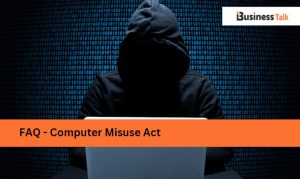
Computer Misuse Act – Law for Computer Criminals
In this digital age, computers play a significant role in our lives, and along with the advancements, the threat of cybercrime is also increasing. This is where the Computer Misuse Act comes into play. The act was introduced in the UK to fight cybercriminals and ensure the safety of computer systems. In this blog, we will explain what the Computer Misuse Act entails, why it is necessary, and how it impacts businesses.
We will look at the different offenses and penalties under the act, including section 3 of the Computer Misuse Act. We will also investigate ransomware and how it breaks the Computer Misuse Act. So, if you are interested in understanding the laws for computer criminals, this blog is for you.
What is the Computer Misuse Act?

The Computer Misuse Act 1990 is a law that criminalizes various cyber-related offences in the UK. The act criminalizes unauthorized access to data, computer systems, and the installation of malware. It creates three crimes: illegal access to business accounting software, unauthorized access to computer materials, and unauthorized modification of computer material.
The act was enacted to address cyber-dependent crimes like hacking, denial-of-service attacks, and other forms of cybercrime. The enactment of the act was based on the recommendations of the European Commission for the Protection of Privacy (ELC). Its introduction was necessary to criminalize computer crimes and brings computer offenses under the ambit of the law.
Furthermore, the act serves as a deterrent for malicious activity and sets out severe penalties for offenders. Therefore, it remains relevant and necessary, especially considering the increased use of technology in everyday life.
Why Was the Computer Misuse Act Introduced?
The primary aim of the Computer Misuse Act is to protect computer systems and data protection, security, and confidentiality. The act specifically outlines the penalties for offenders and ensures that perpetrators of cybercrime are brought to justice.
The act is regularly reviewed to ensure that it adequately addresses harmful cyber activity and that law enforcement is given sufficient powers to investigate and take the necessary action. Any violations of the act can lead to severe legal repercussions, including significant fines and imprisonment.
Computer Misuse Act 1990
The Computer Misuse Act of 1990 was passed by the British Parliament, in part as a reaction to the ruling in R v. Gold & Schifreen (1988) 1 AC 1063. The bill’s opponents claimed it needed to be more adequately thought out and hastily introduced. In addition, they claimed that it was frequently impossible to demonstrate purpose and that the bill could not effectively distinguish between “joyriding” hackers like Gold and Schifreen and more serious cybercriminals.
The Act is still regarded as “a solid and adaptable piece of legislation in dealing with cybercrime,” Numerous other nations, notably Canada and the Republic of Ireland, have used it as a model when developing their information security laws. Recently, many changes have been made to maintain the ct.
The Computer Misuse Act 1990 results from a private member’s bill introduced by Conservative MP Michael Colvin and supported by the government. The Act makes it a criminal offense to access data without permission or to install malware such as viruses, spyware, or ransomware. The act aims to maintain data security and protection hence cracking down on computer-related crime.
Computer Misuse Act 2018

The Computer Misuse Act 2018 is a law that covers a range of crimes related to unauthorised access to and interference with computer systems. The Home Secretary launched a review of the CMA in May 2021 to assess its fitness for purpose in light of technological advancements and to ensure law enforcement authorities have the powers to investigate and take immediate action.
The Computer Misuse Act 2011 in Uganda was introduced to provide security for electronic transactions and information systems and protect against the illegal access and abuse of information systems, given the rise in global cybercrime.
One key feature of the CMA is that it does not differentiate between data types, making the misuse of a computer system the key factor in determining whether an offence has been committed, unlike GDPR rules, where the type of data accessed is the crucial factor.
Computer Misuse Act 1998
The Computer Misuse Act 1998 is a law that makes it illegal to access computer systems without authorization. This Act criminalizes computer-based fraud, hacking, and other computer crimes while protecting data and privacy for public and private limited companies. It creates three types of crimes:
- Unauthorized access to computer materials
- Illegal access to computer software
- Interference with computer systems
- The Act protects individuals, small businesses, and the government from cybercrime.
There has been a public Call for Information regarding the review of the Act, and relevant sections can be found on legislation.gov.uk. Other related Acts also work with the Computer Misuse Act, such as the Criminal Justice (Terrorism and Conspiracy) Act of 1998 and the Serious Crime Act of 2015.
Cybercrime is a growing concern for individuals, businesses, and governments alike, and the Computer Misuse Act plays a vital role in deterring and punishing those who commit such crimes.
Computer Misuse Act Offences
The Computer Misuse Act is a law that targets cyber-dependent crimes such as hacking and the misuse of communication systems. The act outlines four different types of offences, including unauthorized access and acts that cause damage to computer systems. Specifically, unauthorized computer access carries a penalty of up to six months in prison.
However, unauthorized access with intent to commit further offences can lead to up to five years imprisonment. In addition, the Act emphasizes the importance of good management and records because it is relevant to electronic records.
Furthermore, the law does not differentiate between data types, unlike the GDPR. The key factor in determining an offence under the Computer Misuse Act is the misuse of a computer system. Computer users must be aware of this law to avoid criminal liability.
Section 3 Computer Misuse Act

Section 3 of the Computer Misuse Act is a significant regulation that prohibits unauthorized access to computer systems or networks. The unauthorized access to data or computer systems to impair, or with reckless disregard for impairing, the operation of a computer can lead to imprisonment for up to 10 years.
The Act also criminalizes installing malware on someone’s computer, including viruses and ransomware. The Computer Misuse Act additionally covers unauthorized acts that may cause significant harm or risk to a computer system. It also prohibits the making, supplying, or obtaining articles that can be used to facilitate offenses under the Act.
Unlike GDPR, the Act does not differentiate between data and personal data. Instead, it focuses on the misuse of a computer system itself. The act covers three different offences: illegal access to computer software, unauthorized access to computer materials, and unauthorized access to commit or facilitate further criminal activity.
How Does the Computer Misuse Act Affect Businesses?
The Computer Misuse Act is a UK criminal law covering cyber-dependent crimes like hacking and misuse of communication systems. It creates three related crimes, specifically targeting illegal access to software development and computer materials and intentional or careless interference with computer operations. The Act covers four offenses, including unauthorized access with the intent to commit further offenses and unauthorized acts that impair computer systems.
In addition, the Act criminalizes unauthorized access to data and installing malware on computers. The Computer Misuse Act directly impacts businesses. Businesses need to have proper security measures in place and monitor the use of their computer systems to prevent unauthorized access or malicious attacks.
Failure to comply with the Act can lead to serious legal consequences, including fines and imprisonment. Therefore, businesses should consider these aspects while working with their computer systems and handling sensitive data.
How Does Ransomware Break the Computer Misuse Act?
Ransomware is malware that locks up a victim’s computer and requires a ransom to be paid to unlock it. It can be considered an unauthorized modification of computer material, violating the Computer Misuse Act. This act was specifically enacted to tackle cyber-dependent crimes such as hacking, misuse of communication systems, and the installation of malware such as ransomware.
On the other hand, the Computer Fraud & Abuse Act criminalizes unauthorized access to a computer, intentional or reckless damage, and trafficking in passwords, among other offenses. A second conviction under the Computer Fraud & Abuse Act carries a higher maximum prison sentence.
While the Computer Misuse Act is an important piece of legislation, it has been criticized for being insufficient in handling unauthorized computer access. To prevent such attacks, it is important to stay cautious and follow proper cyber-security measures to protect personal and business data.
What Happens if You Break the Computer Misuse Act?

The Computer Misuse Act 1990 was enacted to criminalize unauthorized computer or electronic equipment access. The act categorizes three crimes for illegal interference with computer software – unauthorized access to computer systems, installation of malware, and unauthorized modification of computer material.
Unauthorized access and modification of data and the spread of viruses can lead to up to five years of imprisonment and an unlimited fine. This legislation is specifically designed to deal with cyber-dependent crimes, such as hacking and misuse of communication systems. Breaking the Computer Misuse Act of 1990 has severe consequences, including heavy fines and imprisonment, and is a trial-by-jury offence.
Conclusion
In conclusion, the Computer Misuse Act was introduced to prevent unauthorized access to computer systems and to prosecute individuals who misuse them. The act has evolved to keep up with the changing trends in the digital world. The act applies to businesses that maintain and safeguard their clients’ confidential data. Despite the severity of offences, the act might need to be more apparent, and certain situations may require expert legal advice to avoid being sued.
FAQ – Computer Misuse Act

What are the 3 rules of the Computer Misuse Act?
The Computer Misuse Act contains three main crimes:
- Illegal access to software company
- Unauthorized access to computer materials
- Intentional interference with the operation of computers
It covers four criminal offenses, including unauthorized access with intent to commit further offenses, unauthorized acts with intent to impair operation, unauthorized acts causing significant risk of damage, and making, supplying, or obtaining articles for use in these offenses.
The Act criminalizes accessing data without authorization, including hacking and installing malware such as viruses, spyware, or ransomware. Complying with legal and professional obligations under the Act requires good management and records.
It is important to note that, unlike the GDPR, the Act does not differentiate between data types.
What are the types of computer misuse?
There are various types of computer misuse, which are covered under the Computer Misuse Act. The Act criminalizes accessing data without authorization, installing malware on a computer, and acts with the intent to impair computer systems. Cyber-dependent crimes, like hacking and misuse of communications systems, are also specifically legislated under this act.
The Act creates three crimes related to illegal and unauthorized access to computer materials. These types of computer misuse may include intentional or careless interference with the operation of computers, which can have serious consequences for individuals and organizations alike.
Is the Computer Misuse Act still valid?
Yes, the Computer Misuse Act of 1990 is still valid and effective against cybercrime with a high conviction rate. The Act criminalizes illegal access, unauthorized access, and intentional interference with computer operations. However, some critics argue that it fails to recognize the value of ethical hacking.
In May 2021, the Home Secretary announced a review of the CMA to assess whether the current offenses adequately address harmful activities not recognized following technological advances. While the Act has been amended several times to cover new cyber threats, being over 30 years old, it may need to be revised with the current technological advances.
What are the 4 main elements of the Computer Misuse Act?
The Computer Misuse Act includes four criminal offences: unauthorized access, unauthorized acts with intent to impair, making or supplying articles for use in offences under this Act, and the possession of articles for such use.
In addition, the Act specifically targets cyber-dependent crimes like hacking and misuse of communications systems and creates three crimes related to computer access and interference. These crimes include illegal access to computer software, unauthorized access to criminal activity, and interference with computer operations.
What is the punishment for Computer Misuse Act?
Hacking and installation of malware are also illegal under this act. The punishment for Computer Misuse Act offenses can be imprisonment or fines. The provisions do not distinguish between data and personal data, as does the GDPR, with a review conducted in May 2021.





